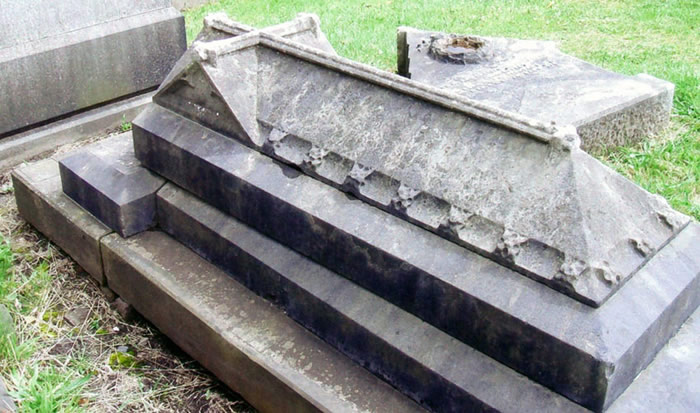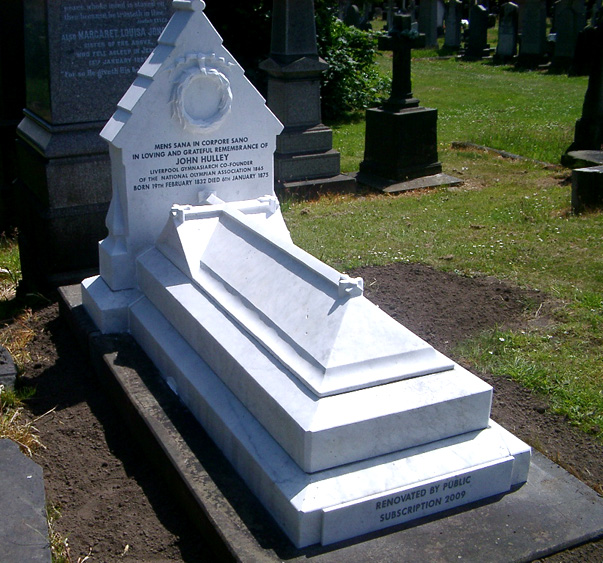|
The Manchester Genealogist
My own Olympic Hero!
Many of us will have enjoyed watching the events of the Beijing Olympics last August and look forward to the London Olympic Games in 2012. I will be particularly keen because I have discovered my own Olympic hero during my family history researches in the past 2½ years.
I am a member of the Guild of One-Name Studies as well as the M&L FHS and collect all references to my surname and its variants like others collect stamps. Indeed, the same enjoyment often occurs – when you finally collect the last stamp in a set of say 12, one gets a sense of achievement. The same goes for family history, but instead of stamps I collect names!
In November 2006 I came across a reference to a John Hulley of Liverpool. The article about him had been written by an ex-Olympic athlete Dr. Don Anthony and was entitled ‘The Roots of Modern Olympism and the Mystery of John Hulley’. This was because he had been the forgotten man of British Olympic history and all trace of him after 1868 had been lost.
Never shirking a challenge of this nature, I decided to follow up this lead to try to solve the mystery. I discovered that Hulley had been born in Liverpool in 1832 and was a descendant of a Hulley family from Frodsham and previously Macclesfield. I have taken this family back to 1488 so he is well founded. His father, 2 uncles, a grandfather and great grandfather had been surgeons or physicians and another uncle had been a chemist and druggist. From an early age Hulley had a keen interest in physical activities, education and fitness. He was taught by Louis Huguenin, the famous French gymnast who had settled in Liverpool in 1844 as a teacher of Gymnastics. John attended Huguenin’s school in a court at the top of Lord Street for several years before matriculating from the Collegiate Institute, Shaw Street, Liverpool in 1850. John was destined to succeed his teacher and became the uncrowned king of the local gymnasts.
In April 1861 John Hulley organised a physical display – called The Assault at Arms – held at the Theatre-Royal which incorporated the demonstration by members of the Liverpool Athletic Club of all kinds of gymnastic equipment. He also delivered an address on Physical Education at the same venue in December 1861 in which he stressed the need for physical as well as mental excellence.
The Liverpool Athletic Club was founded in 1862 at the Rotunda Gymnasium, Bold Street, by John Hulley and Charles Pierre Melly (an ancestor of the late George Melly, musician and entertainer, and Andre Melly film actress) with the motto ‘A healthy mind in a healthy body’. The first Grand Olympic Festival was held at Mount Vernon Parade Ground, Liverpool and John Hulley, Honorary Secretary of the club organised the event. He was praised by Mr. Melly who said that ‘it was entirely owing to John Hulley’s indefatigable and praiseworthy exertions that the festival had been brought to such a successful and highly satisfactory issue’. The Liverpool Mercury reported that:
‘It is due to Mr. John Hulley to state that the whole direction and management of the festival devolved upon him. He was unremitting in his exertions throughout the day, and there is no doubt that to his courtesy and zeal the successful issue of the undertaking was mainly attributed.’
This was followed up by the same event in 1863, 1864, 1865 and 1866, the latter being held at Llandudno. The new Liverpool Gymnasium was officially opened on 19 July 1864 in Myrtle Street by the Mayor, with John Hulley as manager and self-styled Gymnasiarch (an Athenian officer who superintended the gymnasia).
The National Olympian Association (NOA) was founded at this Gymnasium on 6 November 1865 under Hulley’s chairmanship, and together with Dr William Brookes of the Wenlock Olympian Society and Ernst George Ravenstein, Honorary Director of the German Gymnastic Society in London, Hulley masterminded the 1st National Olympian Games in London in 1866.
In 1864 John Hulley had the time and inclination to write to The Times suggesting that England should adopt a type of bathing dress used by continentals – ‘Gentlemen, wives and daughters walking down to the water were all dressed in a seemly yet convenient fashion. The men wear simply loose, baggy trousers, and a skirted Garibaldi of the same or corresponding material. The ladies wear what may be described as a simple Bloomer costume, consisting of jackets, shaped variously according to taste, and loose trousers reaching to the ankle. The dress is completed by slippers, to protect the feet from the shingle, and a straw hat, neatly trimmed to protect the fair wearer's complexion. Although he had a supporter, I don’t wonder that the idea never caught on over here!
Hulley and a colleague called Colin Cummins were at the centre of the exposure of two visiting American music hall artists – the Davenport Brothers - who tried to con audiences in 1865 with an escape from an allegedly escape- proof cabinet. This and the resultant court case attracted widespread coverage by the national press and the brothers were sued for the return of money paid to witness a séance, which did not take place. They were found guilty and had to repay all admission money.
In 1867 John Hulley and Ernst Ravenstein, President of the German Gymnastic Society, London published a book entitled ‘A Handbook of Gymnastics and Athletics’. A Grand Assault at Arms was again held at the Liverpool Gymnasium, Myrtle Street, under the direction of John Hulley and another Olympic Festival was held in July of the same year at Liverpool. Another Olympic Festival was held at Liverpool in June 1868, this time being named the Fifth Olympic Festival of the Athletic Society of Great Britain with John Hulley as its Vice-President.
On 16 July 1869 at The Ancient Unitarian Chapel, Toxteth Park John married Georgiana Bolton, only daughter of Mr. Robert Lewin Bolton, merchant of Liverpool and grand-daughter of the late Mr. Thomas Bolton who was Mayor of Liverpool in 1840. A daughter Georgiana Theodosius was born in December 1870. For some time in the early 1870s he had suffered from a chest complaint which necessitated his removal from England to a warmer climate during the severity of the winter. Reports show that he lived in Algiers, Nice and other Mediterranean resorts during these periods. He finally succumbed to his complaint on 6 January 1875 when he died of Emphysema of lungs and Bronchitis.
The National Olympian Association lasted until 1883 and its Olympian Games ‘were open to all comers’. The NOA and its motto were inherited by the National Physical Recreation Society (NPRS) in 1885/1886 and the NPRS was a founder body of the British Olympic Association in 1905. Indeed the President and the Treasurer of the NPRS were members of Coubertin's ‘Comite Brittanique’ in 1902. So there is a direct link between Hulley's views and aspirations in 1864 and the modern British Olympic movement. My next task was to track down the location of Hulley’s grave. I was assisted by the report of his funeral In the local paper dated 12 January 1875 which read inter alia ‘The funeral of the late Mr. John Hulley, the ‘gymnasiarch,’ took place yesterday morning at the Smithdown-lane cemetery, the body being conveyed in a hearse drawn by four horses, and followed by two mourning coaches and the private carriage of Mr. Aaron Brown.’ Liverpool Record Office were very helpful in locating the grave reference and on one of my trips to Lancashire I decided to look for the actual grave in Smithdown Lane (now Road) cemetery. Thanks to a large plan at the entrance it was a simple task to find the grave. Unfortunately it had been badly damaged in that the headstone had been pushed over – luckily on its back so that the inscription was just about readable.

Grave as found in January 2008
This action had probably been done deliberately by the cemetery authorities following a fatality involving a child playing in a Yorkshire graveyard when a loose headstone collapsed. All local authorities were instructed to examine all cemeteries and where a headstone was in a dangerous condition it had to be made safe.
I contacted Dr Anthony and Ray Physick of Liverpool, an author of sports books who had expressed an interest in the John Hulley story, and we decided to set up a Memorial Fund through a website to raise money for the restoration of Hulley’s grave; to increase awareness of his part in the founding of the British Olympic movement and to revive the interest in him as one of England's finest and forward-looking men. We obtained quotations from several Liverpool stonemasons, one of whom gave us a surprise. They informed us that Hulley’s grave in Smithdown Road cemetery consisted of two separate sections – the vertical headstone which had been laid down and the ‘covers’ of the actual grave next to it. Because the latter had no identifying marks on it, I hadn’t realised that it was part of the grave.
The website is at www.johnhulleymemorialfund.co.uk and we have received donations from The International Olympic Committee in Switzerland, The British Olympic Association, several ex-Olympic athletes and several other people. At the time of writing we are still seeking donations to cover the cost of renovation; the damage to the grave caused by 130 years of acidic atmospheric pollution will be removed and it will be brought back to its original condition of white Italian marble. All the original inscription on the headstone will be re-lettered and the inscriptions ‘John Hulley - Liverpool Gymnasiarch Co-Founder of the National Olympian Association 1865’ and (on a separate stone) ‘Renovated by Public Subscription 2009’ will be added. A provisional date for the re-dedication ceremony at the cemetery has been set for Sunday 14 June 2009 and all donors will receive an invitation to the ceremony. Liverpool Hope University are hoping to arrange refreshments, with all surplus funds being given to local sporting charities.

Renovated grave in June 2009
The existence of the website has already prompted a member of the public to contact me to advise that, during an attic clearance, she found the silver medal which was given to John Hulley in 1864 by the Wenlock Olympian Society ‘as a mark of their appreciation of his talented and valuable services in the cause of physical education’. She has agreed that the medal will be loaned to the new Liverpool museum which opens in 2010.
This story has shown that through careful research of several different sources it is possible to reveal some of one’s more interesting ancestors. The on-line newspaper websites obtainable by membership of the Lancashire County Council Library service at www.lancashire.gov.uk/libraries (open to all applicants irrespective of location) is a particularly good resource. Unfortunately I am not a direct ancestor of John Hulley the Liverpool Gymnasiarch but I am proud to be associated with the renovation of his grave as a tribute to his devotion to physical education and the British Olympic cause.
Footnotes
Journal of Olympic History Vol 9 No. 1 (Winter 2001)
TNA Chancery papers C 15/204/H136
The History and Hulley Families of the One House, Rainow (ISBN 0-9540314-0-7 pub. 2001)
Ches03 family tree in www.hulley.info
Liverpool Mercury 7 Nov 1865 – Some Old Liverpudlians – No. 11 John Hulley
Ibid 25 Apr 1861
Ibid 5 Dec 1861
Ibid 29 Sep 1862
Ibid 16 Jun 1862
Ibid 15 Jun 1863
Ibid 2 Jul 1864
Website of the North of England Athletic Association at www.noeaa-athletics.org.uk
Porcupine magazine report 12 May 1866
Liverpool Mercury 7 Nov 1865
The Times 6 Aug 1864
Ibid 8 Aug 1864
Ibid 29 Mar 1865
 Top
of Page Top
of Page |
|
Copyright © 2000-2022 Ray Hulley. All rights reserved.
|
|


